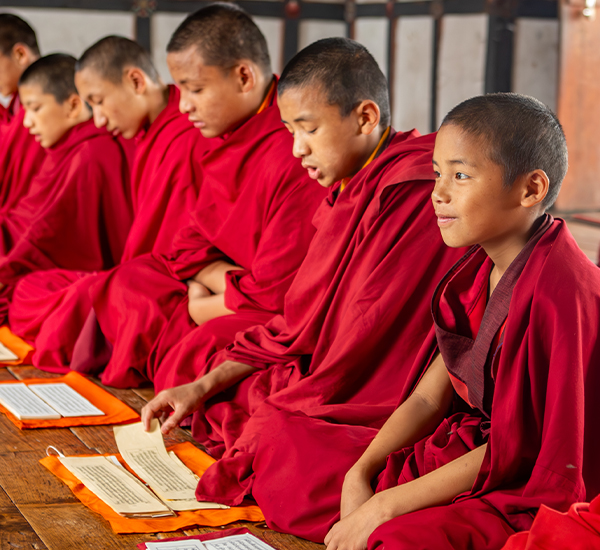History
Bhutan’s rich history spans over 4,000 years, with its roots reaching back to 2000 BC. Early records are limited, yet the historical and cultural landscape began to form significantly with the arrival of Guru Padmasambhava (Guru Rinpoche) in 746 AD. His visit is pivotal in Bhutanese history, as he played a crucial role in converting the King and much of the population to Buddhism, which became and remains the foundation of Bhutan’s culture, philosophy, and way of life.
Flora and Fauna
Bhutan is a botanical paradise, home to an extraordinary diversity of over 5,600 plant species, representing nearly 60% of all plant species found in the eastern Himalayas. Orchids, rhododendrons, and blue poppies—the national flower—flourish here, creating a vibrant tapestry of biodiversity. Bhutan also harbors a vast array of wildlife within its protected forests, including elusive species such as snow leopards, red pandas, and musk deer. The Bhutanese people’s deep respect for nature is reflected in the strict prohibition of hunting and a shared belief in “lay ju dray” (karma), reinforcing the philosophy that every action has consequences.
People
Bhutan’s population is a rich mosaic of three major ethnic groups, each contributing to the country’s cultural and regional diversity. The Bhutia, the largest group, largely shape Bhutan’s political and cultural landscape. The Nepalese community, comprising about one-third of the population, resides primarily in the southern regions, adding to Bhutan’s multicultural fabric. The Sharchop, believed to be the country’s earliest settlers, reside in the east and have ancestral ties to tribes in neighboring Assam and Arunachal Pradesh. Renowned for their warmth, the Bhutanese people welcome visitors with genuine hospitality, creating a serene and harmonious atmosphere across the kingdom.
Culture and Tradition of Bhutan
Bhutan is a culturally vibrant nation with a population of approximately 700,000, where traditions, values, and spirituality shape daily life. Bhutanese people are strong, resilient, and take pride in their colorful, traditional attire. Arts, crafts, ceremonies, and festivals are still practiced in their ancient forms, passed down through generations as living history. Buddhism, the state religion, weaves through all aspects of Bhutanese culture, from daily rituals to grand festivals. Monasteries, stupas, and the constant presence of prayer flags dot the landscape, imbuing the countryside with the teachings of compassion, mindfulness, and interconnectedness.
How to Reach Bhutan
By Air
Paro International Airport is the sole airport serving Bhutan, and it is the primary entry point for international travelers. The airport is nestled in a picturesque valley, offering stunning views of the surrounding mountains during descent. Druk Air is the only airline operating flights to and from India, with routes connecting major cities such as Delhi, Kolkata, and Mumbai. The flight experience is unique, as passengers are treated to breathtaking vistas of the Himalayas, making the journey to Bhutan a memorable one.
By Train
For those traveling from India by train, the nearest railway stations are Hasimara and New Alipurduar, both located in the Indian state of West Bengal. Once you arrive at either station, you can easily arrange for transportation to Bhutan. Shared taxis, individual cabs, or buses are available to take you to the border town of Phuentsholing, Bhutan's primary land entry point. The journey from the train stations to Phuentsholing typically takes about an hour, offering a scenic glimpse of the lush landscape along the way.
By Road
Bhutan is also easily accessible by road from India, with three designated land borders: Phuentsholing, Gelephu, and Samdrup Jongkhar. Travelers can cross into Bhutan from India at these points. The journey from major cities like Guwahati or Siliguri to Bhutan takes approximately three hours. The roads are generally well-maintained, and the route offers travelers beautiful views of the Indian and Bhutanese countryside, creating a picturesque travel experience.





